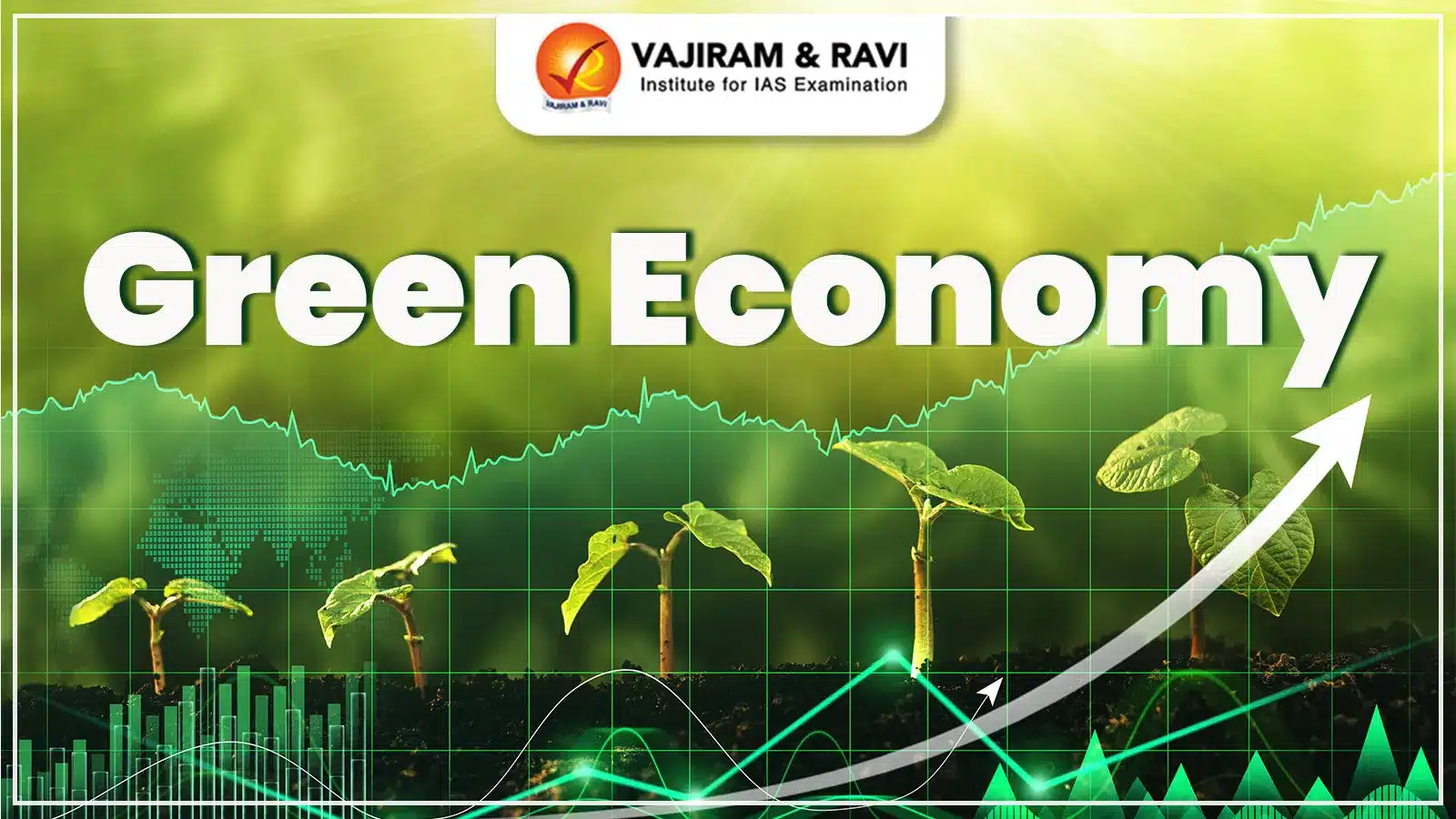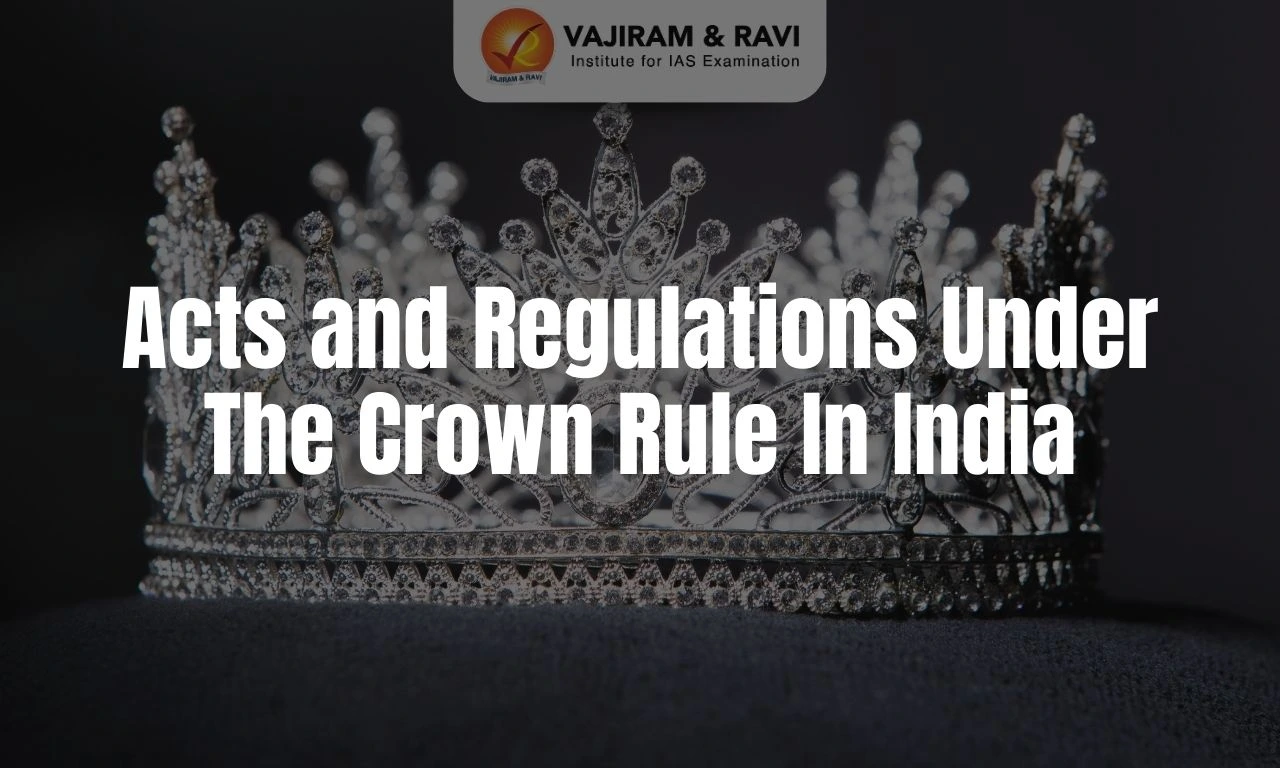Green Economy is a shift towards sustainable development, balancing economic growth with environmental protection and social equity. Defined by low carbon emissions and efficient resource use, it promotes inclusive growth through green investments, policy reforms, and sustainable practices. Unlike traditional economies, it prioritises eco-friendly initiatives like renewable energy and circular models. Core principles include fairness, justice, and resource conservation.
India's green economy transition shows promise, particularly in renewable energy, though challenges like heavy fossil fuel reliance and infrastructure bottlenecks remain significant obstacles.
What is Green Economy?
A green economy is defined by low carbon emissions, resource efficiency, and social inclusion, where growth is driven by investments that reduce pollution, enhance energy efficiency, and protect ecosystems. These green investments require public spending, policy reforms, and regulatory changes to support sustainable growth across all major sectors of Indian economy.
- Natural Capital for Growth: The UN Environment Programme (UNEP) highlights natural capital as a key economic asset, particularly for impoverished communities, focusing on promoting economic growth that benefits both people and the planet.
- Sustainable Consumption & Efficiency: Sustainable consumption and production aim to reduce resource use, emissions, and waste throughout the product lifecycle, while resource efficiency maximises value with fewer resources.
- Green Economy Framework: The Green Economy framework promotes sustainable economic growth through green finance, technology, and investment, supporting countries in developing policies that enable a transition to more resilient, inclusive, and digitally integrated economies, contributing to the growth of the digital economy.
- Connection with Blue Economy: The green economy and blue economy are interconnected, as both aim for sustainable development by conserving natural resources—green focusing on land and energy, blue on oceans and coasts—creating holistic environmental and economic benefits.
How does Green Economy differ from traditional economy?
The green economy focuses on sustainability, reducing environmental impact, and integrating economic, environmental, and social factors, unlike traditional models that mainly focus on GDP and lead to resource depletion and pollution. The difference between the two is as follows:
|
Aspect |
Green Economy |
Traditional Economy |
|
Resource Use |
Emphasizes sustainable use and conservation of natural resources. |
Often leads to over-exploitation and depletion of resources. |
|
Economic Growth |
Growth is driven by investments in sustainable practices and technologies. |
Growth is often achieved through industrial expansion and resource extraction. |
|
Social Equity |
Focuses on social inclusion and equity, ensuring benefits are widely shared. |
May exacerbate social inequalities, prioritizing profit over equitable distribution. |
|
Waste Management |
Advocates for waste minimization, recycling, and a circular economy approach. |
Often follows a linear model of "take-make-dispose," leading to high waste levels. |
|
Investment Focus |
Promotes investments in sustainable practices, energy efficiency, and the use of renewable energy sources. |
Investments often favour fossil fuels and traditional industries with high emissions. |
Green Economy Principles
The green economy emphasises shared prosperity, fairness, and resource conservation, directly contributing to sustainable development and helping countries meet their SDG Goals through sector-specific initiatives.
- The Wellbeing Principle: A green economy creates shared prosperity, focusing on human, social, physical, and natural capital, and invests in sustainable systems, infrastructure, and education to provide green jobs and livelihoods.
- The Justice Principle: It ensures fairness across generations, promotes equitable opportunities, supports women's empowerment, and fosters social justice for small enterprises and vulnerable groups.
- The Planetary Boundaries Principle: A green economy protects and restores biodiversity and natural systems, following the precautionary principle to prevent resource depletion and support sustainable livelihoods.
- The Efficiency and Sufficiency Principle: It promotes sustainable consumption and production, conserving resources, adopting low-carbon models, and aligning costs with environmental and societal well-being.
- The Good Governance Principle: A green economy relies on accountable, interdisciplinary institutions that promote transparency, public participation, and decision-making to serve both society and sustainability.
India's Status as a Green Economy
India is steadily progressing towards a green economy, with ambitious plans and achievements. India’s green economy is projected to reach a value of $1 trillion by 2030 and $15 trillion by 2070, with the potential to create 7.29 million green jobs by FY28 and 35 million by 2047.
- India’s renewable energy capacity has grown to 220.10 GW, with a record 29.52 GW added in one year—of which 23.83 GW came from solar energy alone.
- The country aims to achieve 500 GW of non-fossil fuel-based capacity by 2030, aligning with its ‘Panchamrit’ climate commitments.
- India secured the 10th position in the 2025 Climate Change Performance Index (CCPI), maintaining its status as one of the world’s leading nations in climate action, despite a minor decline in ranking.
- However, India’s 176th rank in the 2024 Environmental Performance Index (EPI) reflects severe air pollution (177th in air quality), high coal dependence, and lagging biodiversity efforts.
- While renewable investments and a 2070 net-zero goal signal progress, coal remains a key energy source, contributing to GHG emissions and poor air quality.
- India has launched numerous initiatives, such as the National Action Plan on Climate Change and the Production Linked Incentive (PLI) scheme for solar PV modules.
- The country is also part of international collaborations like the Indo-German Task Force and the International Partnership for Hydrogen and Fuel Cells in the Economy (IPHE).
Strategies for Achieving a Green Economy
To transition effectively to a green economy, a comprehensive strategy is essential, incorporating a range of approaches that address economic restructuring, resource efficiency, and sustainable development.
- Green Economic Development: Adopting green economic development strategies involves supporting businesses that improve environmental outcomes, integrating sustainability into traditional economic growth, and fostering industries focused on clean technologies and renewable resources.
- Resource Efficiency and Green Purchasing: Enhancing resource efficiency and implementing green purchasing policies help reduce operational costs, lower environmental impacts, and stimulate demand for energy-efficient products and services within communities and businesses.
- Local Production and Utilisation: Promoting local production and consumption strengthens regional self-reliance, creates high-quality jobs, and minimises the environmental footprint associated with transporting goods over long distances.
- Waste Stream Management: Implementing effective waste stream management, such as aggressive recycling and zero waste initiatives, reduces disposal costs, creates green jobs, and transforms waste into valuable resources or energy.
- Green Infrastructure: Developing green infrastructure through smart land use and zoning decisions improves environmental quality, supports sustainable economic activity, and enhances the overall quality of life for residents.
Green Economy Importance
India’s shift to a green economy is vital for sustainable development, offering immense potential for job creation, climate resilience, clean technology expansion, and long-term economic growth through environmentally responsible policies and investments.
- Job Creation: India's shift to a net-zero economy could generate 50 million jobs and contribute $15 trillion to the economy, as projected by the World Economic Forum.
- Economic Growth and Innovation: Transitioning to a green economy fosters sustainable economic growth by promoting low-carbon technologies and practices, leading to innovation and new business opportunities across various sectors.
- Environmental Risk Reduction: Adopting green economic practices significantly reduces environmental risks and resource scarcity, ensuring long-term ecological balance and sustainability for future generations.
- Social Inclusion and Equity: The green economy emphasises inclusive growth, ensuring that the benefits of sustainable development are equitably shared, thereby reducing inequalities and promoting social well-being.
- Alignment with Sustainable Development Goals: Implementing green economy strategies aligns with global Sustainable Development Goals, particularly those focusing on clean energy, sustainable cities, and climate action, fostering a holistic approach to development.
Green Economy Challenges
Despite significant progress and ambitious goals, India's transition to a green economy faces several challenges. These challenges are multifaceted and arise across various sectors, including energy, agriculture, industry, and finance.
- Heavy Reliance on Fossil Fuels: India remains highly dependent on fossil fuels for its energy needs, with coal accounting for over 70% of electricity generation. Despite substantial growth in renewable energy, the fossil fuel share is expected to remain significant in the near future.
- High Investment Needs: To decarbonise, India may require an estimated $7.2 trillion in green investments by 2050 under the line-of-sight scenario and an additional $4.9 trillion under the accelerated scenario.
- Infrastructure Bottlenecks: India’s existing infrastructure needs significant upgrades to accommodate renewable energy. The power transmission infrastructure, in particular, requires expansion to integrate renewable energy from remote locations.
- The lack of modernised grid infrastructure can slow down the push for green energy and result in inefficiencies.
- Land Acquisition: Land acquisition for renewable energy projects, especially solar and wind farms, remains a significant challenge. This issue is particularly acute in densely populated areas and regions with competing land use demands.
- Dependency: India still imports over 40% of its primary energy requirements, worth over USD 90 billion annually. More investment is needed in R&D, especially in storage solutions for renewable energy.
Green Economy Initiatives Launched by the Government
India has launched several green economy initiatives to promote sustainable development, reduce carbon emissions, and transition to clean energy, reflecting its commitment to environmental protection and climate action goals.
- National Green Hydrogen Mission: Launched in 2023, this mission aims to make India a global hub for green hydrogen by targeting 5 million metric tonnes annual production by 2030, attracting over ₹8 lakh crore investment and creating 6 lakh jobs.
- National Action Plan on Climate Change: The National Action Plan on Climate Change (NAPCC) includes missions like the National Solar Mission, National Mission on Sustainable Habitat, and National Mission on Energy Efficiency, focusing on emission reduction and clean energy promotion.
- PM-KUSUM Scheme: Started in 2019, PM-KUSUM promotes solar energy in agriculture by subsidizing new and existing solar-powered irrigation pumps, aiming to solarize 49 lakh agricultural pumps and reduce farmers’ dependence on fossil fuels.
- Green Grids Initiative – One Sun, One World, One Grid: Proposed by India and launched at COP26 in 2021, this initiative seeks to interconnect global solar energy grids, facilitating cross-border renewable energy sharing and enhancing energy security.
- Green Credit Programme: Introduced in October 2023, this market-based initiative incentivizes individuals and organizations to undertake voluntary environmental actions, such as afforestation, by awarding tradable green credits.
Partnership for Action on Green Economy (PAGE)
The Partnership for Action on Green Economy (PAGE) focuses on integrating sustainability into economic policymaking. It assists countries in reshaping their economic policies to drive sustainable growth, create jobs, reduce poverty and inequality, and enhance ecological resilience.
- Launched in 2013 as a response to the Rio+20 Declaration, PAGE combines the expertise of five United Nations (UN) agencies—UNEP, ILO, UNDP, UNIDO, and UNITAR—to provide coordinated technical assistance and capacity-building.
- PAGE supports the 2030 Agenda for Sustainable Development, especially SDG 8, by promoting inclusive, sustainable economic growth and decent work.
- The partnership coordinates United Nations efforts and offers holistic support to help countries implement green economy strategies effectively.
Green Economy UPSC PYQs
Question 1: The Partnership for Action on Green Economy (PAGE) a UN mechanism to assist countries in transition towards greener and more inclusive economies, emerged at: (UPSC Prelims 2018)
(a) The Earth Summit on Sustainable Development 2002, Johannesburg
(b) The United Nations Conference on Sustainable Development 2012, Rio de Janeiro
(c) The United Nations Framework Convention on Climate Change 2015, Paris
(d) The World Sustainable Development Summit 2016, New Delhi
Answer: (b)
Last updated on December, 2025
→ Check out the latest UPSC Syllabus 2026 here.
→ Join Vajiram & Ravi’s Interview Guidance Programme for expert help to crack your final UPSC stage.
→ UPSC Mains Result 2025 is now out.
→ UPSC Notification 2026 is scheduled to be released on January 14, 2026.
→ UPSC Calendar 2026 is released on 15th May, 2025.
→ The UPSC Vacancy 2025 were released 1129, out of which 979 were for UPSC CSE and remaining 150 are for UPSC IFoS.
→ UPSC Prelims 2026 will be conducted on 24th May, 2026 & UPSC Mains 2026 will be conducted on 21st August 2026.
→ The UPSC Selection Process is of 3 stages-Prelims, Mains and Interview.
→ UPSC Result 2024 is released with latest UPSC Marksheet 2024. Check Now!
→ UPSC Prelims Result 2025 is out now for the CSE held on 25 May 2025.
→ UPSC Toppers List 2024 is released now. Shakti Dubey is UPSC AIR 1 2024 Topper.
→ UPSC Prelims Question Paper 2025 and Unofficial Prelims Answer Key 2025 are available now.
→ UPSC Mains Question Paper 2025 is out for Essay, GS 1, 2, 3 & GS 4.
→ UPSC Mains Indian Language Question Paper 2025 is now out.
→ UPSC Mains Optional Question Paper 2025 is now out.
→ Also check Best IAS Coaching in Delhi
Green Economy FAQs
Q1. What do you mean by green economy?+
Q2. What are the five pillars of the green economy?+
Q3. What best describes a green economy?+
Q4. Is India a green economy?+
Q5. What are the main objectives of a green economy?+

















